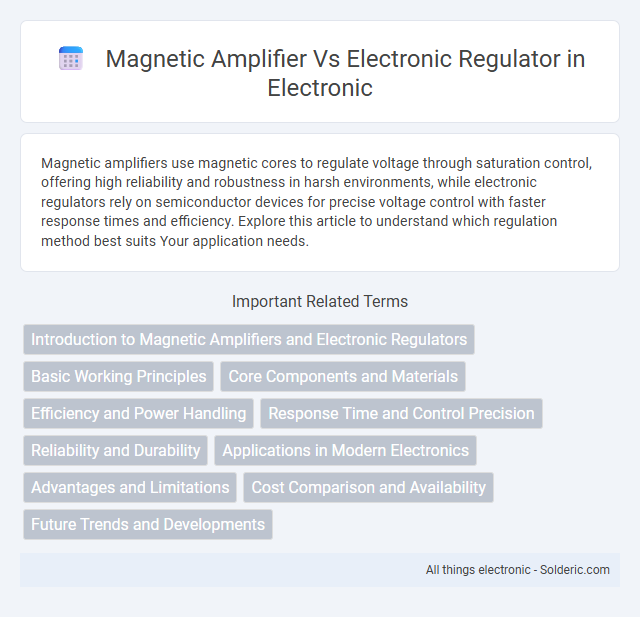Magnetic amplifiers use magnetic cores to regulate voltage through saturation control, offering high reliability and robustness in harsh environments, while electronic regulators rely on semiconductor devices for precise voltage control with faster response times and efficiency. Explore this article to understand which regulation method best suits Your application needs.
Comparison Table
| Feature | Magnetic Amplifier | Electronic Regulator |
|---|---|---|
| Operating Principle | Uses magnetic saturation in a transformer core to control output | Uses semiconductor devices to regulate voltage/current |
| Response Speed | Slower, limited by magnetic core properties | Fast, immediate electronic switching |
| Efficiency | Moderate, with core and copper losses | High, minimal conduction losses |
| Durability | Robust, resistant to radiation and electrical noise | Moderate, sensitive to temperature and spikes |
| Maintenance | Low, fewer moving parts | Requires occasional component replacement |
| Applications | High-power industrial controls, aerospace, military | Consumer electronics, power supplies, automotive |
| Cost | Higher initial cost due to magnetic materials | Lower, mass-produced semiconductor components |
| Size | Bulkier due to transformer cores | Compact, suitable for integrated circuits |
Introduction to Magnetic Amplifiers and Electronic Regulators
Magnetic amplifiers use saturated magnetic cores to control power flow by varying the magnetic flux with a control winding, offering high reliability and robustness in harsh environments. Electronic regulators rely on semiconductor devices such as transistors or integrated circuits to maintain voltage or current levels with precise and fast response times. Both devices serve critical roles in power control, but magnetic amplifiers excel in durability, while electronic regulators provide greater efficiency and flexibility.
Basic Working Principles
Magnetic amplifiers control electrical power by saturating magnetic cores with direct current, allowing precise adjustment of output voltage through changes in magnetic flux. Electronic regulators use semiconductor components like transistors to rapidly switch or modulate voltage, providing efficient and fast voltage regulation. Understanding the basic working principles of these devices helps you choose the right solution for applications requiring stable power control.
Core Components and Materials
Magnetic amplifiers utilize ferromagnetic cores made from high-permeability materials such as silicon steel or ferrites, which enable efficient magnetic flux modulation for voltage regulation. Electronic regulators rely on semiconductor components like transistors, diodes, and integrated circuits composed of silicon or gallium arsenide to control current flow and maintain output stability. Understanding the core materials is essential for optimizing Your system's performance, as magnetic amplifiers excel in high-temperature environments while electronic regulators offer fast response times and compact designs.
Efficiency and Power Handling
Magnetic amplifiers offer higher efficiency in power handling due to their ability to operate with minimal energy loss under heavy load conditions, often exceeding 90% efficiency compared to electronic regulators. They excel in high-voltage and high-current applications, sustaining power without heat dissipation typical of semiconductor-based electronic regulators. Electronic regulators, while providing precise control and fast response times, generally exhibit lower efficiency and reduced power handling capacity due to switching losses and thermal limitations.
Response Time and Control Precision
Magnetic amplifiers exhibit slower response times compared to electronic regulators due to their reliance on magnetic saturation and inductive components, which introduce inherent delays. Electronic regulators offer superior control precision through rapid switching and feedback mechanisms, allowing for finer adjustments in voltage and current output. This makes electronic regulators more suitable for applications demanding high responsiveness and exact regulation.
Reliability and Durability
Magnetic amplifiers offer exceptional reliability and durability due to their robust construction and absence of delicate semiconductor components, making them resistant to harsh environmental conditions and electrical surges. Electronic regulators, while providing precise control, typically rely on sensitive components that can degrade over time and are more susceptible to failure from voltage spikes and thermal stress. For applications demanding long-term stability and minimal maintenance, your choice of a magnetic amplifier ensures superior endurance and operational consistency.
Applications in Modern Electronics
Magnetic amplifiers are commonly used in high-power applications such as power supplies for industrial equipment and military systems due to their robustness and ability to handle large currents without semiconductor failure. Electronic regulators, including linear and switching regulators, dominate consumer electronics, providing precise voltage control for devices like smartphones, laptops, and LED lighting systems. The choice between magnetic amplifiers and electronic regulators depends on factors like power level, efficiency requirements, and environmental conditions.
Advantages and Limitations
Magnetic amplifiers offer high reliability and robustness in harsh environments due to their simple construction and lack of active semiconductor components, making them resistant to radiation and electrical noise. Their primary limitation is slower response time and larger size compared to electronic regulators, which provide faster, more precise control with compact designs ideal for modern applications. Your choice depends on the need for durability versus speed and miniaturization in power regulation tasks.
Cost Comparison and Availability
Magnetic amplifiers generally offer a lower initial cost and simpler construction compared to electronic regulators, making them more accessible for applications requiring ruggedness and reliability under harsh conditions. Electronic regulators, while often more expensive upfront due to advanced semiconductor components, benefit from widespread availability and integration in modern systems, driving economies of scale. The cost-effectiveness of magnetic amplifiers is balanced by the broad market presence and component standardization favoring electronic regulators.
Future Trends and Developments
Magnetic amplifiers are experiencing renewed interest due to their robustness and high reliability in harsh environments, with future trends focusing on integrating advanced magnetic materials to enhance efficiency and power density. Electronic regulators continue to evolve with innovations in semiconductor technology, emphasizing miniaturization, faster response times, and improved energy efficiency through digital control systems and AI-driven optimization. Hybrid solutions combining magnetic amplifiers and electronic regulators are emerging, leveraging the strengths of both technologies to achieve superior performance in power management applications.
magnetic amplifier vs electronic regulator Infographic

 solderic.com
solderic.com